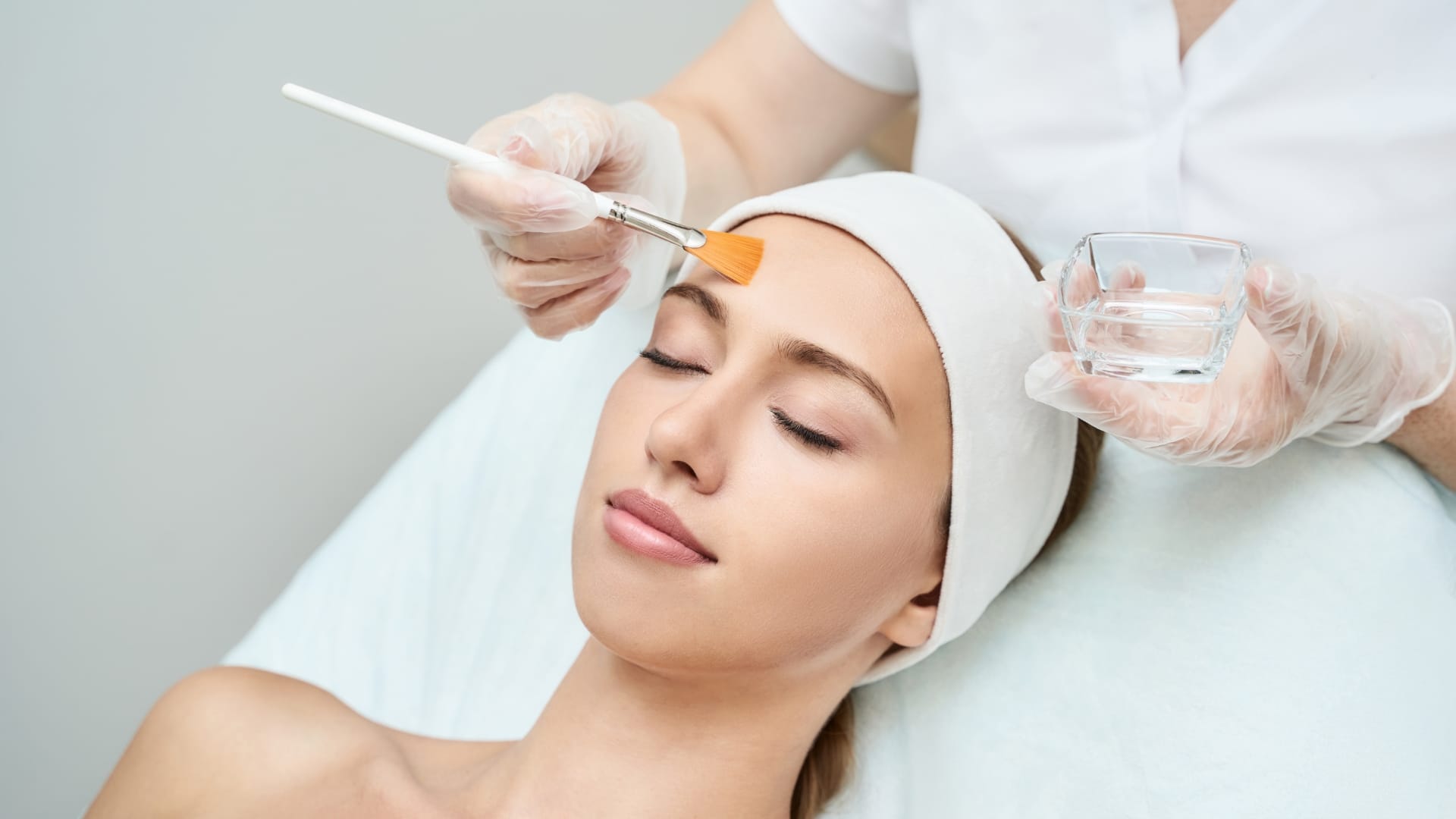Ageing gracefully is an art and a big challenge in this highly polluted environment. Our skin, our first line of defence, is vulnerable to dirt, pollutants, and the sun’s harmful UV rays. Fortunately, an effective treatment known as Chemical Peel can help you achieve healthier, younger-looking skin.
Basically, a chemical peeling treatment is a cosmetic procedure or, more precisely, a resurfacing treatment for the skin. It is a non-invasive procedure done on the face, neck and hands using a combination of powerful yet skin-safe acids to improve the appearance of the skin. This concoction of acids exfoliates the epidermis or the topmost skin layer to expose the healthier layers underneath. The acids also stimulate elastin and collagen production to make the skin softer, supple, and toned.
Understanding Chemical Peeling Treatment & Its Types
There is no one-solution-fits-all for chemical peels. Various types of skin-safe acids and solutions are used to treat different types of skin and skin conditions. The chemical solution used also differs according to how deeply it penetrates the skin.
Since there are many aspects to consider, only a certified specialist, such as a dermatologist, can determine the right chemical peel for your skin.
Based on your skin type and requirements, your doctor may recommend any one of the following chemical peels:
As the name implies, light chemical peels use very gentle chemicals like alpha and beta hydroxy acids that penetrate the skin’s topmost layer to act;
- Fine wrinkles
- Acne and dryness
- Discolouration of the skin
- Uneven texture of the skin
Light chemical peel requires multiple sessions to achieve the desired results. In most cases, recovery is quick, with little or no downtime.
2. Medium chemical peel
Medium peels use slightly stronger chemicals like trichloroacetic acid, Jessner’s solution, and glycolic acid to remove skin cells from the top and middle layers. These solutions can effectively act on:
- Acne scars
- Skin discolouration
- Removal of dead skin cells
- Fine lines and wrinkles
- Age spots
Unlike light chemical peel, patients require downtime of one week to recover from a medium chemical peel.
3. Deep chemical peel
This chemical peel process uses trichloroacetic or carbolic acid, producing the most dramatic results because they penetrate deeper into the middle skin layers. Your doctor may recommend deep chemical peels to treat:
- Deep running wrinkles
- Age spots and scars
- Precancerous growths
- Skin discolouration
- Dead skin cells
Deep chemical peels are more complex and effective than light and medium peels. Sometimes the patient may require sedation or local or general anaesthetic during the procedure. In terms of recovery time, pre-preparation and post-care, deep chemical peels require about 4 to 8 weeks, which is the longest amongst all chemical peel types. However, this method gives the best results with just one session.
Preparing For A Chemical Peel: What You Should & Should Not Do
The preparation for a chemical peel is an important step in determining the safety and efficacy of the procedure. Moreover, the preparation steps and duration vary depending on the type of chemical peel and your skin issue.
Here’s a list of do’s and dont's to follow before a chemical peel:
Do not:
- Use retinoid cream for a week before the treatment.
- Expose yourself to harsh sunlight, tanning beds, and saunas for several weeks.
- Tan, wax, or use depilatory creams that cause skin irritation.
- Use specific cosmetic treatments like facial masks, laser resurfacing, and hair removal.
Do:
- Take the prescribed antiviral medication for a week before the treatment.
- Use hydroquinone for a few days before treatment.
What happens during the chemical peeling process?
Chemical peels are done by trained professionals well-versed in handling and applying the chemicals. The professional commences the procedure by gently cleaning the skin surface to remove dead skin cells, dirt, cosmetic residues and other debris.
Depending on your skin type and requirements, a customized chemical concoction is applied with a brush on the target areas. Based on the condition of the skin and the type of chemical used, it could be salicylic acid, glycolic acid, lactic acid or mandelic acid.
What happens here is this: The chemicals loosen the bond binding the dead skin cells. The chemical is left on the skin, giving it a few minutes to act on the targetted blemishes. It is then neutralized and removed from the area. The underlying fresh layer of skin is exposed to replace the old one.
Sounds like magic? This is more of a chemical and biological process than a magic trick. For a better understanding of the chemical peel process, let's unravel what really happens.
How Do Chemical Peels Work: A Step-wise Analysis of What Happens
The strength of each chemical peel determines how deep it will penetrate the skin to treat the blemishes. This penetration depth also affects the healing process's duration and efficacy. Basically, every person’s skin and skin-related issues are different, which is why chemical peels are available in varying strengths.
If you opt for a chemical peel, here’s what you will probably experience during the process:
Day 1: Depending on the peel depth and your skin’s sensitivity, you may feel:
- Throbbing sensations
- Mild skin irritation
- Mild stinging sensation like a sunburn
Your doctor will recommend ice packs and medications to relieve these after-effects.
Days 2-4: Here’s what you may experience after the first day of the chemical peel treatment:
- Tightness and dryness of the skin.
- Stinging sensation and pain (if you have had deeper chemical peel)
- Flakiness as the top layers start shedding.
Days 4-7: Almost a week after your treatment, you may experience:
- Continual flaking and peeling
- More visibility of blemishes and skin discolourations (this is normal)
In some cases, your chemical peel professional may recommend a gentle cleanser followed by a strong moisturizer.
One to two weeks: The skin should stop shedding the topmost layer for lighter chemical peels. The swelling will subside within this timeline for medium and deeper peels, but the redness may remain for at least three months. You will notice new, healthy, smooth, and supple skin in the following days.
While the recommended waiting time between treatments is four to six weeks, most patients may require four to six sessions for the best results.
How safe are chemical peels?
Chemical peels are safer than facials primarily because it is a minimum-touch process. However, it is imperative that you rely only on a certified skin expert or licensed medical professional for the process because it is not a random cosmetic procedure. To achieve optimal results, it is very important that you diligently follow your doctor’s pre-and post-procedure instructions.
Valuable Tips to Care For Your Skin Post Chemical Peeling Treatment
Although different chemical peel types require other aftercare routines, many general tips apply to all chemical peels. You should:
- Avoid exposing your skin to harsh sunlight.
- Avoid scratching, rubbing, and picking on your skin.
- Keep yourself cool and avoid sweating too much.
- Use a broad-spectrum sunscreen with SPF 30+.
- Take the medication prescribed by your doctor.
A final word
Chemical peels are fast gaining traction for their long-term results, low risk, and dramatic outcome. There is a general preference for light and medium peels since they are less invasive. However, it is best to consult with your doctor and follow their advice to may this process worthwhile.
To know more about this game-changing procedure, please contact our experts at AKJ Skin and Laser Centre in Tirunelveli.

